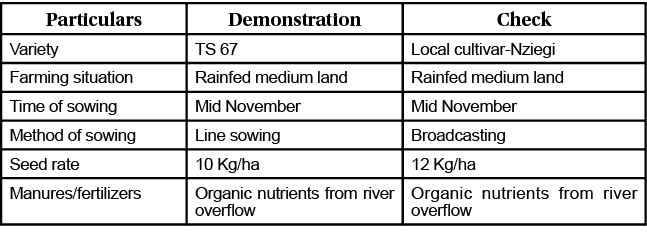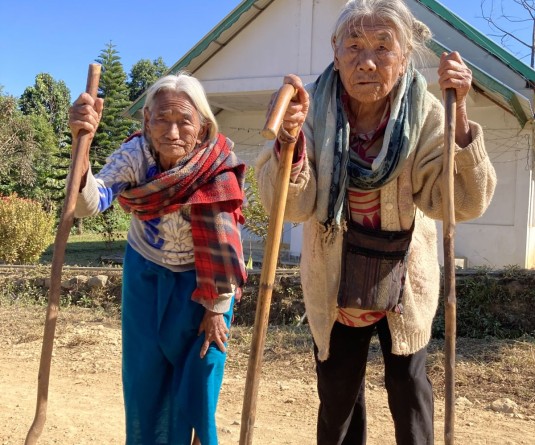
In Peren, oilseed crops are mainly cultivated in the lower laying areas of the district bordering Assam and Dimapur in Nagaland. Two such villages are Beisumpuikam and Jalukiekam. Usually during monsoon, the Tamaki (Dhansiri) river in Beisumpuikam and the Mongleu River in Jalukiekam overflows and causes flooding in the nearby adjoining areas. By mid-September the flood water starts receding and the land gets accumulated with rich nutrients from the flood water. By mid-October, the lands get dry and farmers start to cultivate toria in these nutrient rich soils on the river banks by November. Sometimes, due to erratic monsoon, the water accumulates for more days and the sowing of oilseeds gets delayed. Due to this the crop may get Aphid infestation, resulting in low yield of the crop; thus, reducing farmers’ income. Delay in sowing also adversely influence the crop performance, due to depletion of soil moisture. In order to overcome this problem of late sowing, so that income of the farmers is not affected by poor growth, KVK Peren has introduced a new variety TS-67, a popular late sown variety developed by RARS, Jorhat. The plant type is semi erect and medium in height with a duration of 90-95 days. Oil content is 40.7-42.3 %. The yield is 10-12 qt/ha in timely sown crop and 7.01 qt/ha for late sown up to December.
Objective of the study:
In the present study, comparison of improved variety with improved practices and Local cultivar with farmer’s traditional practice were conducted to determine the suitability of Toria variety under adverse condition without affecting its normal yield.
Materials and Method:
The study was carried out during rabi season in 2019-20 and 2020-21 years by Krishi Vigyan Kendra (KVK), Peren under ICAR Research Complex for NEH, Region, Nagaland Centre, Medziphema. The demonstrations on TS-67 variety were conducted in Beisumpuikam and Jalukiekam, two different villages. A total of 20 farmers were selected for the study covering an area of 5 ha under rainfed condition. Farmers were trained on improved cultivation practices of Toria before land preparation for cultivation. In these trainings, farmers were trained on selection of quality seed materials, importance of line sowing, various intercultural operation such as timely thinning, weeding and plant protection measures.
Table.1 Details of demonstration and farmers’ practice for cultivation of Toria in the study

Result:
In 2019, both TS67 as well as Local cultivars were sown in mid-November. Variety TS-67 matured earlier and performed well and produced a yield of 9.21q/ha. Whereas, Local cultivar was late maturing and had more no. of branches, size of silique and seeds were small compared to TS-67 variety and produced a yield of 6.8q/ha under farmers traditional method of cultivation. The study was continued in the following year 2020, but due to the continuous dry spell, all the winter crops including Toria could not do well. Since TS 67 is short duration variety, flowering was not much affected. Flowering formation took place along with pod setting but in the local variety due to its long duration, it could not set flowering properly and yield was very much reduced.
Table 2: Pooled data of yield in demo and check of two years 2019 and 2020 is listed below

Conclusion:
Toria crop is most sensitive to moisture stress from vegetative to early flowering stage (Singh et al., 1991) affecting flowering and early siliqua formation causing poor seed filling. Since the farmers in the region are devoid of irrigation facilities, under the adverse condition of drought, Toria variety TS-67 was proven to be a boon for the farmers.
Reference:
Singh, P.K; Mishra, A.K; Imtiyaz, M., 1991. Moisture stress and water use efficiency of mustard. Agril. Water Mngt., 20(3), 245-253.
Article contributed by Patu K Zeliang, KVK Peren, ICAR Research Complex for NEH Region, Nagaland Centre, Peren and Harendra Verma, ICAR Research Complex for NER, Nagaland Centre, Medziphema




